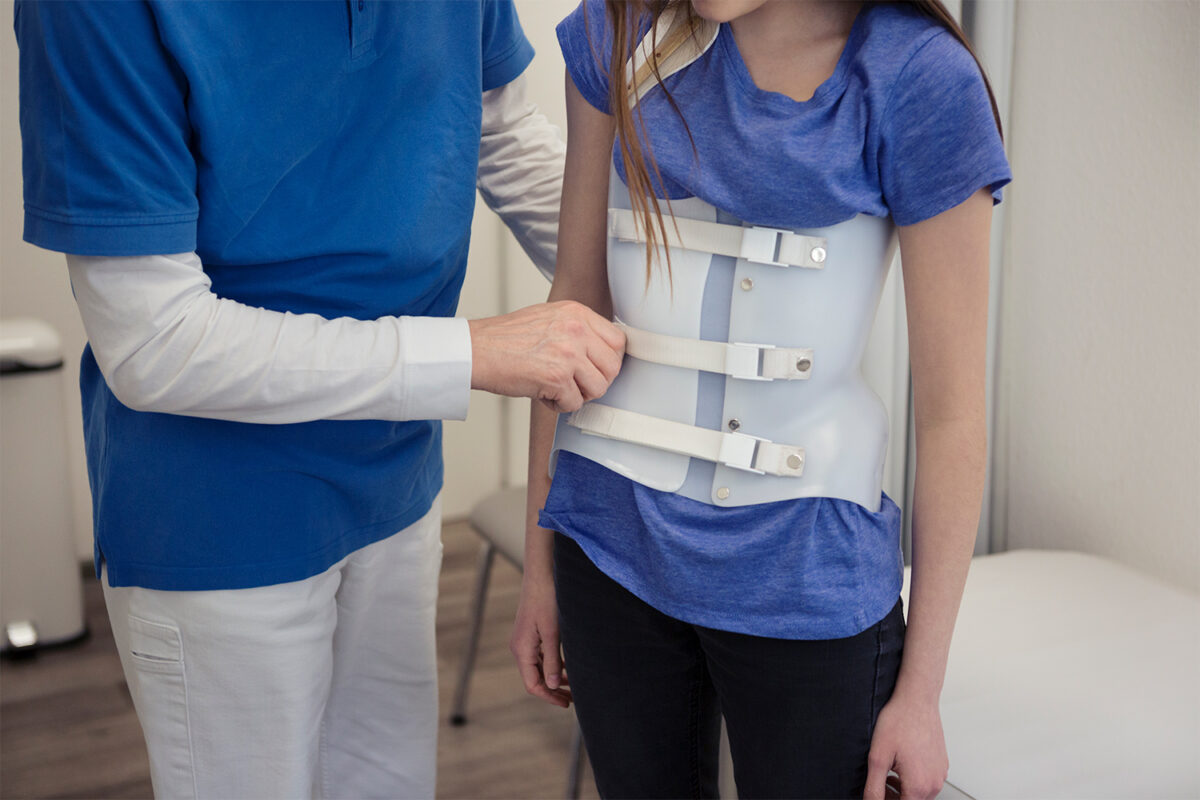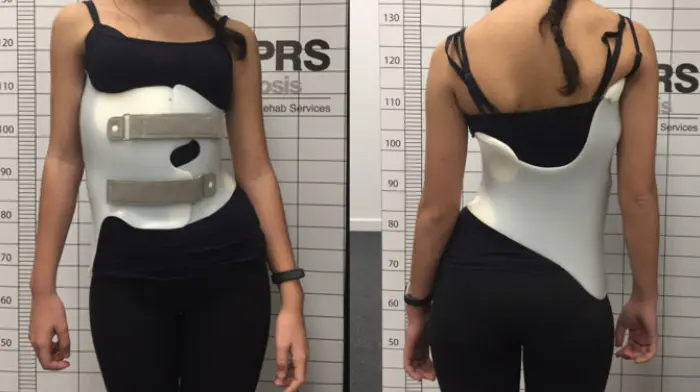脊柱側湾症は、背骨の異常な湾曲を特徴とし、一般的に青年に多く見られる。しかし、成人の約6%もこの症状を経験していると推定されています。脊柱側湾症の成人にとって、背中矯正器具は、症状を管理し、痛みを和らげるために必要不可欠なものです。この記事では、脊柱側湾症の成人に対する背筋矯正の効果、利用可能な矯正器具の種類、矯正器具を選ぶ際に考慮すべき重要な要素についてご紹介します。
成人の脊柱側湾症を理解する
成人の脊柱側弯症は、背骨の退行性変化、小児脊柱側弯症の未治療、または既存のカーブの進行によって生じます。症状は、軽い不快感から激しい痛み、運動能力の低下まで様々です。適切な治療は、症状の管理だけでなく、湾曲のさらなる進行を防ぐためにも不可欠です。

原因と症状
成人の脊柱側弯症の多くは、加齢による脊柱の変性が原因ですが、先天性の奇形や思春期に診断されなかった脊柱側弯症もあります。一般的な症状としては、慢性的な背中の痛み、不揃いな肩、日常生活の困難などがあります。
脊柱側湾症治療における背部ブレースの重要性
背中の矯正器具は、脊柱側湾症の成人のための非侵襲的な治療オプションです。脊椎を支え、痛みを軽減し、場合によっては湾曲の進行を遅らせるように設計されています。圧力をかけ、適切なアライメントを促進することで、背筋装具は姿勢を改善し、日常生活での安定性を高めます。
成人脊柱側湾症患者のための背部ブレースの種類
一般的な歯列矯正の種類
成人の脊柱側弯症管理には、数種類の背部装具が利用できる:
- ボストン・ブレイス:胴体を覆う硬いオーダーメイドの装具で、中等度の湾曲によく処方される。
- チャールストン・ベンディング・ブレース:寝ている間に矯正力を加えるように設計された夜間装具。
- ミルウォーキー・ブレース:首から骨盤まで伸びる胴体全体の装具で、一般的に重度の湾曲症に使用される。
正しいブレースの選択
装具の選択は、脊柱側湾症の重症度、患者の活動レベル、快適さの好みによって決まります。専門医に相談することで、患者のライフスタイルにシームレスにフィットしながら、最大限の効果を発揮する装具を選択することができます。

成人用脊柱側湾症背部ブレースの有効性の評価
臨床エビデンスとアウトカム
成人の脊柱側弯症に対する背部装具の効果を調査した研究では、さまざまな結果が示されている。装具が痛みを大幅に軽減し、湾曲を安定させることを示す研究がある一方で、長期的な結果には限界があることを強調する研究もある。成功には、装具の種類、装着期間、患者のアドヒアランスなどの要因が重要である。
個別の治療計画
装具の効果には個人差があります。脊柱側弯症の進行を防ぐことができる人もいれば、部分的な緩和しか得られない人もいます。最良の結果を得るためには、医療専門家の指導のもと、個人個人に合わせたアプローチが必要です。
脊柱側湾症背部ブレースの利点と限界
主なメリット
背中の矯正には、以下のような利点がある:
- 痛みの緩和:背骨を安定させることで、背中の筋肉への負担を減らし、痛みを和らげることができる。
- 姿勢の改善:装具を定期的に使用することで、姿勢が良くなり、さらに湾曲が進むリスクを減らすことができます。
- 安定性の向上:歯列矯正は、大きな不快感を感じることなく、活動的なライフスタイルを維持することを可能にします。
限界を認識する
しかし、背筋矯正器具は脊柱側湾症の治療器具ではありません。背骨の湾曲を完全に矯正することはできませんし、長時間装着していると不快に感じることもあります。さらに、日常生活の中で、動きが制限されたり、装具に慣れるのが難しくなったりする人もいます。
大人のための背筋ブレースを選ぶ際に考慮すべき要素
湾曲の程度と生活習慣要因
背中の装具を選ぶ際には、湾曲の程度、活動レベル、快適性を考慮することが不可欠です。脊柱側湾症を専門とする医療従事者は、これらの要素を評価し、患者のライフスタイルに合ったフィット感のある装具を提案する必要があります。
オーダーメイドと既製ブレース
オーダーメイドのブレースは、既製品と比較して、より良い快適性とサポートを提供し、オーダーメイドのフィット感を提供します。カスタムメイドの矯正器具は高価ですが、特定のニーズにより効果的に対応することができます。既製のブレースは、より手頃な価格ですが、同じレベルの精度は提供できないかもしれませんが、それでもかなりのサポートを提供できます。

バックブレースの正しい装着とメンテナンスのコツ
ブレース装着のベストプラクティス
最適な結果を得るためには、医療提供者のガイドラインに従うことが重要です。定期的な調整と点検により、装具の効果が持続するようにします。患者は、毎日推奨される時間装具を着用し、装具を適切に手入れし、皮膚の炎症を避けるために清潔を保つ必要があります。
定期的なモニタリングと調整
時間の経過とともに、背骨が調整されたり、装具が摩耗したりすると、調整が必要になります。定期的なフォローアップの予約により、適切なメンテナンスが可能になり、ブレースが必要なサポートを提供し続けることができます。
成人の脊柱側湾症に対する代替治療の選択肢
脊柱側弯症の治療において、背中の装具は不可欠な要素ですが、装具を補う、あるいは場合によっては装具に代わる代替治療もあります。以下のようなものがあります:
- 理学療法:体幹の筋肉を強化し、柔軟性を向上させるエクササイズ。
- カイロプラクティック・ケア:痛みを軽減し、機能を改善するための非侵襲的な脊椎調整。
- 手術の選択肢:保存的治療が無効な重症例では、手術が必要になることもある。
サクセスストーリー成人用脊柱側湾症背部ブレースの実体験
多くの大人が、背筋矯正装具のおかげで生活の質が大幅に改善したことを経験している。例えば、35歳の退行性脊柱側弯症のサラは、オーダーメイドの装具を6ヶ月間使用した後、痛みが軽減し、姿勢が改善したと報告した。彼女の体験は、個人に合った治療計画がいかに成功につながるかを浮き彫りにしている。
結論成人用脊柱側湾症背部ブレースについて十分な情報を得た上で決断する
脊柱側湾症の成人にとって、背中の矯正器具は痛みの管理、姿勢の改善、安定性のために有効な選択肢です。脊柱側湾症の専門医に相談し、湾曲の程度や患者独自のニーズに基づいて最適な治療法を検討することが重要です。背筋矯正の利点と限界の両方を考慮し、補完的な治療法を模索することで、個人は十分な情報を得た上で決断し、可能な限り最良の結果を得ることができます。
参考文献
- Katzman WB, Cawthon P, Ensrud KE, et al. "Lifestyle Interventions and Their Role in Treating Scoliosis in Elderly Adults.". 骨・ミネラル研究ジャーナル.2020;35(9):1703-1710: 10.1002/jbmr.4093.
- Weinstein SL, Dolan LA, Wright JG, Dobbs MB."特発性側弯症の青年におけるブレースの効果" ニューイングランド・ジャーナル・オブ・メディシン.2013;369(16):1512-1521: 10.1056/NEJMoa1307337.
- Negrini S, Aulisa AG, Aulisa L, et al. "2016年SOSORTガイドライン:成長期における特発性側弯症の整形外科的治療とリハビリテーション治療". 脊柱側湾症と脊椎疾患.2018;13:3: 10.1186/s13013-017-0145-8.
- Dolan LA, Weinstein SL.「思春期の特発性側弯症に対する装具戦略」。 骨・関節外科ジャーナル.2021;103(4):346-354: 10.2106/JBJS.20.01519.
- Monticone M, Ambrosini E, Cazzaniga D, et al. "Active Self-Correction and Task-Oriented Exercises Reduce Spinal Deformity and Improve Quality of Life in Subjects with Mild Adolescent Idiopathic Scoliosis.". ヨーロピアン・スパイン・ジャーナル.2014;23(6):1204-1214: 10.1007/s00586-014-3241-y.
- Zhang H, Zhang L, Zhang Z, et al. "Bracing for Adolescent Idiopathic Scoliosis in China:A Systematic Review." 整形外科研究ジャーナル.2020;15(1):29: 10.1186/s13018-020-1549-0.
- Lonstein JE.「脊柱側湾症:外科的治療と非外科的治療の比較". 臨床整形外科学および関連研究.2006;(443):248-259: 10.1097/01.blo.0000198726.67831.87.
- Negrini S, Donzelli S, Negrini A, et al. "How to Monitor the Results of Bracing in Adolescent Idiopathic Scoliosis: 2018 SOSORT Guidelines". 脊柱側湾症と脊椎疾患.2018;13:24: 10.1186/s13013-018-0162-x.
- Bunnell WP."骨格成熟前の特発性側弯症の自然史" 背骨.1986;11(8):773-776: 10.1097/00007632-198611000-00005.
- Day GA, Hayes B, Suh JH."装具と理学療法による成人側弯症の管理". 理学療法科学ジャーナル.2020;32(8):563-569: 10.1589/jpts.32.563.
- 大鳥慎一郎、鈴木正樹、越俊彦、他。"成人脊柱側弯症に対する手術と保存的治療"。 背骨.2013;38(24):2127-2134: 10.1097/BRS.0000000000000017.
- Chen Z, Xu N, Zhang Y, et al. "Long-Term Outcomes of Non-Surgical Management of Degenerative Scoliosis in Elderly Patients". 整形外科科学ジャーナル.2019;24(6):1025-1031: 10.1016/j.jos.2019.06.012.
- Horng MH, Hsu PC, Su FC, et al. "Comparison of effectiveness of Bracing and Exercise for Adolescent Idiopathic Scoliosis". 整形外科.2020;43(4). doi: 10.3928/01477447-20200625-03.
- Parent EC, Newton PO, Wenger DR, et al. "Early Spinal Deformity Detection:脊柱側弯症の進行予防におけるスクリーニングとブレースの役割". 脊椎ジャーナル.2020;45(4):216-222: 10.1097/BRS.0000000000003275.
- Rigo M, Negrini S, Weiss HR, et al. "Surgical Versus Non-Surgical Treatment in Adults with Idiopathic Scoliosis". ヨーロピアン・スパイン・ジャーナル.2010;19(10):1597-1606: 10.1007/s00586-010-1397-2.

